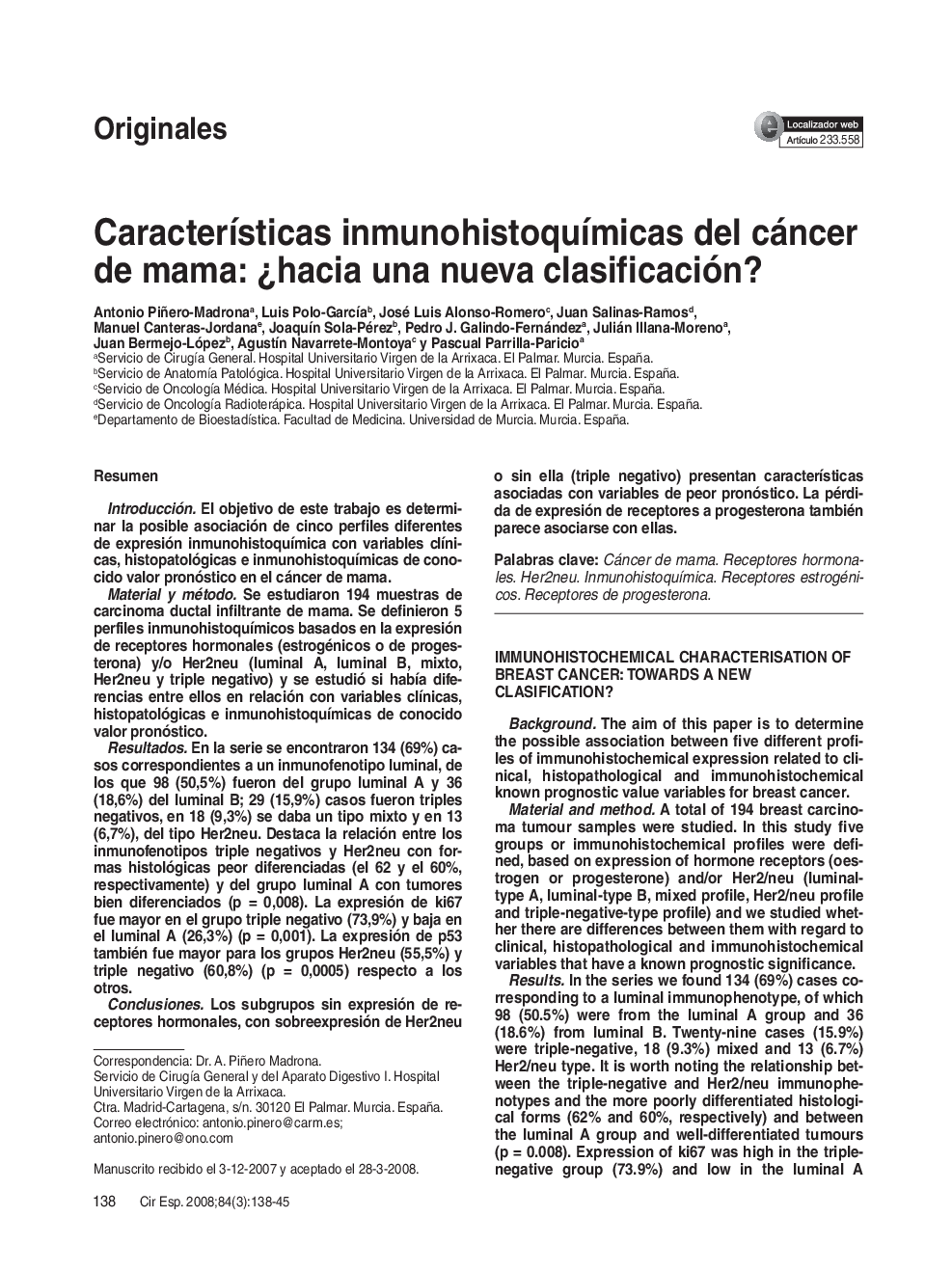| Article ID | Journal | Published Year | Pages | File Type |
|---|---|---|---|---|
| 4253864 | Cirugía Española | 2008 | 8 Pages |
ResumenIntroducciónEl objetivo de este trabajo es determinar la posible asociación de cinco perfiles diferentes de expresión inmunohistoquímica con variables clínicas, histopatológicas e inmunohistoquímicas de conocido valor pronóstico en el cáncer de mama.Material y métodoSe estudiaron 194 muestras de carcinoma ductal infiltrante de mama. Se definieron 5 perfiles inmunohistoquímicos basados en la expresión de receptores hormonales (estrogénicos o de progesterona) y/o Her2neu (luminal A, luminal B, mixto, Her2neu y triple negativo) y se estudió si había diferencias entre ellos en relación con variables clínicas, histopatológicas e inmunohistoquímicas de conocido valor pronóstico.ResultadosEn la serie se encontraron 134 (69%) casos correspondientes a un inmunofenotipo luminal, de los que 98 (50,5%) fueron del grupo luminal A y 36 (18,6%) del luminal B; 29 (15,9%) casos fueron triples negativos, en 18 (9,3%) se daba un tipo mixto y en 13 (6,7%), del tipo Her2neu. Destaca la relación entre los inmunofenotipos triple negativos y Her2neu con formas histológicas peor diferenciadas (el 62 y el 60%, respectivamente) y del grupo luminal A con tumores bien diferenciados (p = 0,008). La expresión de ki67 fue mayor en el grupo triple negativo (73,9%) y baja en el luminal A (26,3%) (p = 0,001). La expresión de p53 también fue mayor para los grupos Her2neu (55,5%) y triple negativo (60,8%) (p = 0,0005) respecto a los otros.ConclusionesLos subgrupos sin expresión de receptores hormonales, con sobreexpresión de Her2neu o sin ella (triple negativo) presentan características asociadas con variables de peor pronóstico. La pérdida de expresión de receptores a progesterona también parece asociarse con ellas.
BackgroundThe aim of this paper is to determine the possible association between five different profiles of immunohistochemical expression related to clinical, histopathological and immunohistochemical known prognostic value variables for breast cancer.Material and methodA total of 194 breast carcinoma tumour samples were studied. In this study five groups or immunohistochemical profiles were defined, based on expression of hormone receptors (oestrogen or progesterone) and/or Her2/neu (luminal-type A, luminal-type B, mixed profile, Her2/neu profile and triple-negative-type profile) and we studied whether there are differences between them with regard to clinical, histopathological and immunohistochemical variables that have a known prognostic significance.ResultsIn the series we found 134 (69%) cases corresponding to a luminal immunophenotype, of which 98 (50.5%) were from the luminal A group and 36 (18.6%) from luminal B. Twentynine cases (15.9%) were triple-negative, 18 (9.3%) mixed and 13 (6.7%) Her2/neu type. It is worth noting the relationship between the triple-negative and Her2/neu immunophe-notypes and the more poorly differentiated histological forms (62% and 60%, respectively) and between the luminal A group and well-differentiated tumours (p = 0.008). Expression of ki67 was high in the triple-negative group (73.9%) and low in the luminal A group (26.3%; p = 0.001). The expression of p53 was also greater for the Her2/neu (55.5%) and triple-negative (60.8%) groups (p = 0.0005) than for the others.ConclusionsThe subgroups without hormone receptor expression, with Her2/neu overexpression or without (triple-negative group), have characteristics associated with variables of a poorer prognosis. The lack of progesterone receptor expression also seems to be associated with these.
